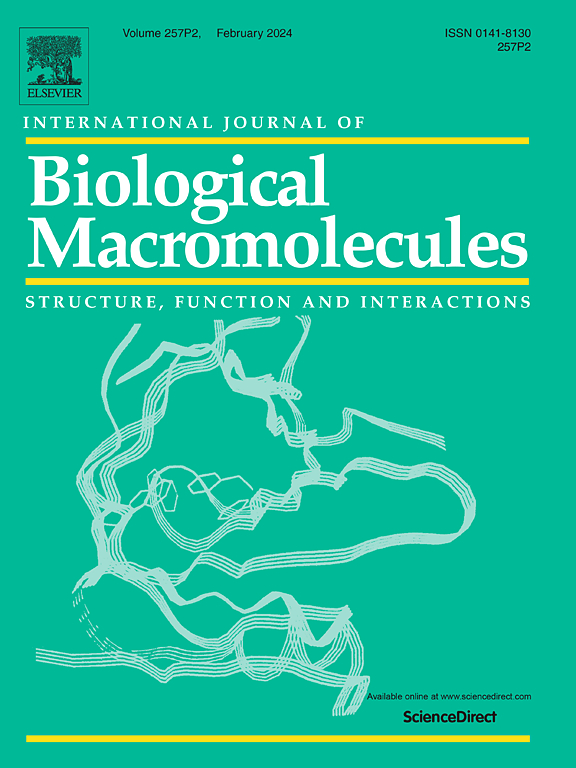壳聚糖/羧甲基纤维素微聚电解质复合物(PECs)对烟酰胺(维生素 B3)的输送和控释能力。
IF 7.7
1区 化学
Q1 BIOCHEMISTRY & MOLECULAR BIOLOGY
International Journal of Biological Macromolecules
Pub Date : 2024-12-01
DOI:10.1016/j.ijbiomac.2024.137848
引用次数: 0
摘要
由于胃肠道中存在许多生理屏障,因此给药生物活性化合物是一项挑战。为了应对这些挑战之一,我们开发了壳聚糖/羧甲基纤维素微聚电解质复合物(micro-PECs),无需使用交联剂,即可携带烟酰胺(一种亲水性生物活性剂模型)。采用方框-贝肯设计法研究了 CMC/CHS 微 PECs 的加工时间(X1:60、120 或 180 分钟)、pH 值(X2:3、4 或 5)和烟酰胺浓度(X3:0.02、0.04 和 0.06,g-L-1)对烟酰胺包封效率(Y1)和负载量(Y2)的影响。封装效率(Y1)在 0.86 % 到 80.78 % 之间变化,而负载能力(Y2)在 0.03 % 到 3.89 % 之间变化。通过静态胃肠道模型对含有烟酰胺的 CMC/CHS micro-PECs 的消化率进行了体外评估。烟酰胺释放动力学数据拟合了经验模型(零阶、一阶、Higuchi 和 Korsemeyer-Peppas)。零阶模型在所有点(胃消化和肠道消化)上的拟合效果都最好,零阶常数(K0)~ 0.002-0.003 较低,表明在所有情况下都有规律且缓慢的释放速率。这些结果凸显了 CMC/CHS 微 PECs 作为一种高效、新型口服给药系统的适用性,它超越了传统方法,具有持续释放和高封装效率的特点,且无需使用复杂的交联剂。本文章由计算机程序翻译,如有差异,请以英文原文为准。
Delivery and controlled release abilities of chitosan/carboxymethylcellulose micropolyelectrolyte complexes (PECs) toward niacinamide (vitamin B3)
The administration of bioactive compounds presents challenges due to the numerous physiological barriers in the gastrointestinal tract. To deal with one of these challenges, chitosan (CHS)/carboxymethylcellulose (CMC) micropolyelectrolyte complexes (micro-PECs) were developed without the use of crosslinking agents to carry niacinamide, a model hydrophilic bioactive agent. A Box–Behnken design was used to study the effects of processing time (X1 = 60, 120 or 180 min), pH (X2 = 3, 4 or 5) and niacinamide concentration (X3 = 0.02, 0.04 and 0.06, g·L−1) on the encapsulation efficiency (Y1) and loading capacity (Y2) of niacinamide by CMC/CHS micro-PECs. The encapsulation efficiency (Y1) varied from 0.86 % to 80.78 %, whereas the loading capacity (Y2) varied between 0.03 % and 3.89 %. The digestibility of CMC/CHS micro-PECs containing niacinamide was evaluated in vitro via a static gastrointestinal model. Empirical models (Zero Order, First Order, Higuchi and Korsemeyer-Peppas) were fitted to the niacinamide release kinetics data. The zero-order model exhibited the best fit across all points (gastric and enteric digestion), with low zero-order constants (K0) ~ 0.002–0.003, indicating a regular and subdued release rate in all cases. These results highlight the applicability of CMC/CHS micro-PECs as an efficient, novel oral delivery system, surpassing conventional approaches by offering a sustained release and high encapsulation efficiency, without needing any additional chemical crosslinking agent for their obtention.
求助全文
通过发布文献求助,成功后即可免费获取论文全文。
去求助
来源期刊
CiteScore
13.70
自引率
9.80%
发文量
2728
审稿时长
64 days
期刊介绍:
The International Journal of Biological Macromolecules is a well-established international journal dedicated to research on the chemical and biological aspects of natural macromolecules. Focusing on proteins, macromolecular carbohydrates, glycoproteins, proteoglycans, lignins, biological poly-acids, and nucleic acids, the journal presents the latest findings in molecular structure, properties, biological activities, interactions, modifications, and functional properties. Papers must offer new and novel insights, encompassing related model systems, structural conformational studies, theoretical developments, and analytical techniques. Each paper is required to primarily focus on at least one named biological macromolecule, reflected in the title, abstract, and text.

 求助内容:
求助内容: 应助结果提醒方式:
应助结果提醒方式:


